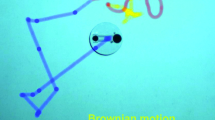Abstract
In this article, I will describe experiments designed to understand how ants estimate the distance they have walked. They rival in their simplicity, the experiments described in my previous article, designed to understand how bees estimate the distance flown. Although ants can also use optic flow to estimate distance, in the absence of optic flow cues and of pheromone/chemical trails, as may sometimes be the case in the desert ants, Cataglyphis, ants estimate the distance walked, not by the energy expended but, believe it or not, by ‘counting’ (or integrating) the number of steps they have taken. This was proved by showing that ants on stilts (elongated legs) overshot the required distance to return home while ants on stumps (shortened legs) undershot the required distance.
Similar content being viewed by others
Suggested Reading
B Hölldobler and E O Wilson, The Ants, Belknap Press of Harvard University Press, USA, 1990.
R Wehner, Arthropods in Animal Homing, Ed. F Papi, Chapman and Hall, London, 1992.
M Wittlinger, R Wehner and H Wolf, An Ant Odometer: Stepping on Stilts and Stumps, Science, Vol.312, pp.1965–1967, 2006.
R Gadagkar, How to Design Experiments in Animal Behaviour: 4. How Do Bees Estimate the Distance Flown? Resonance -journal of science education Vol.24, No.7, pp.739–751, 2019.
M Wittlinger, R Wehner and H Wolf, The Desert Ant Odometer: A Stride Integrator that Accounts for Stride Length and Walking Speed, J. Exp. Biol, 210, Vol.198–207, 2007.
S E Pfeffer and M Wittlinger, Optic Flow Odometry Operates Independently of Stride Integration in Carried Ants, Science, Vol.353, Issue 6304, pp.1155–1157, 2016.
H Wolf, M Wittlinger and S E Pfeffer, Two Distance Memories in Desert Ants - Modes of Interaction, PLoS ONE, 13(10), 2018: e0204664. https://doi.org/10.1371/journal.pone.0204664.
R Wehner, The Cataglyphis Mahresienne: 50 years of Cataglyphis Research at Mahrés, Journal of Comparative Physiology A, Published online, 12th July, 2019, https://doi.org/10.1007/s00359-019-01333-5
R Gadagkar, How to Design Experiments in Animal Behaviour: 1. How Wasps Find Their Nests, Resonance - journal of science education, Vol.23, No.8, pp.871–884, 2018.
Acknowledgement
I thank Rüdiger Wehner, Harald Wolf and T N C Vidya for many helpful comments on this manuscript.
Author information
Authors and Affiliations
Corresponding author
Additional information
Raghavendra Gadagkar is DST Year of Science Chair Professor at the Centre for Ecological Sciences, Indian Institute of Science, Bangalore, Honorary Professor at JNCASR, and Non-Resident Permanent Fellow of the Wissenschaftskolleg (Institute for Advanced Study), Berlin. During the past 40 years he has established an active school of research in the area of animal behaviour, ecology and evolution. The origin and evolution of cooperation in animals, especially in social insects, such as ants, bees and wasps, is a major goal of his research. http://ces.iisc.ac.in/hpg/raghhttps://www.researchgate.net/profile/RaghavendraGadagkar
Rights and permissions
About this article
Cite this article
Gadagkar, R. How to Design Experiments in Animal Behaviour. Reson 24, 875–889 (2019). https://doi.org/10.1007/s12045-019-0850-0
Published:
Issue Date:
DOI: https://doi.org/10.1007/s12045-019-0850-0




